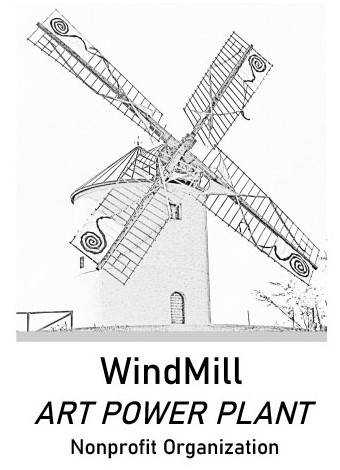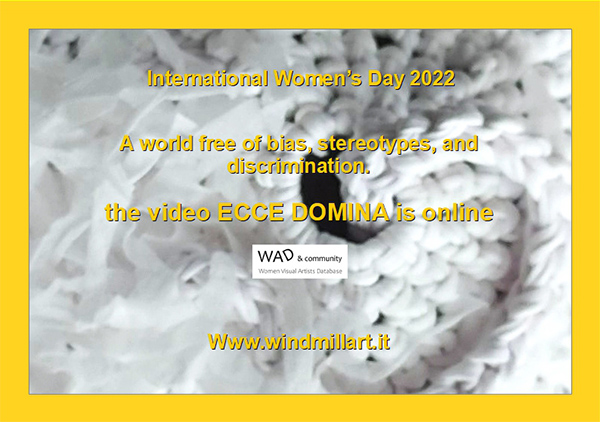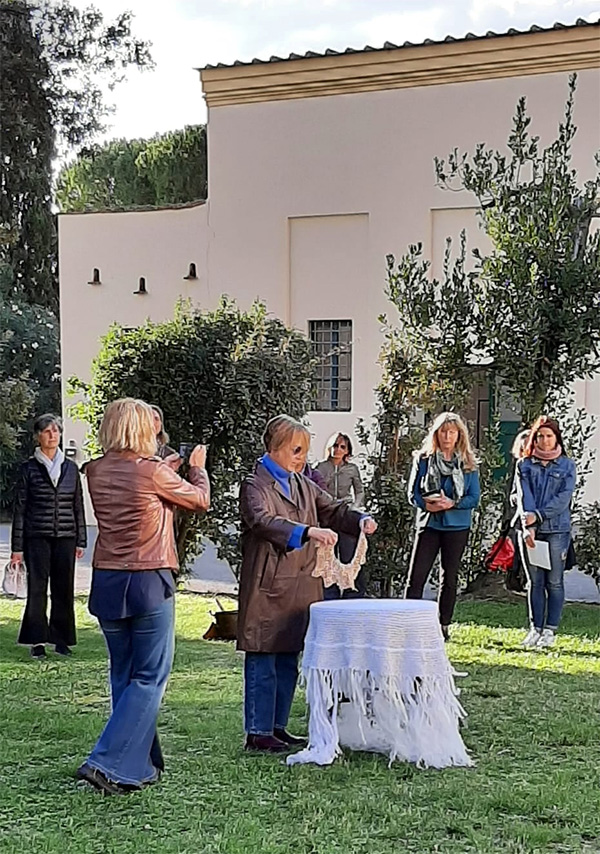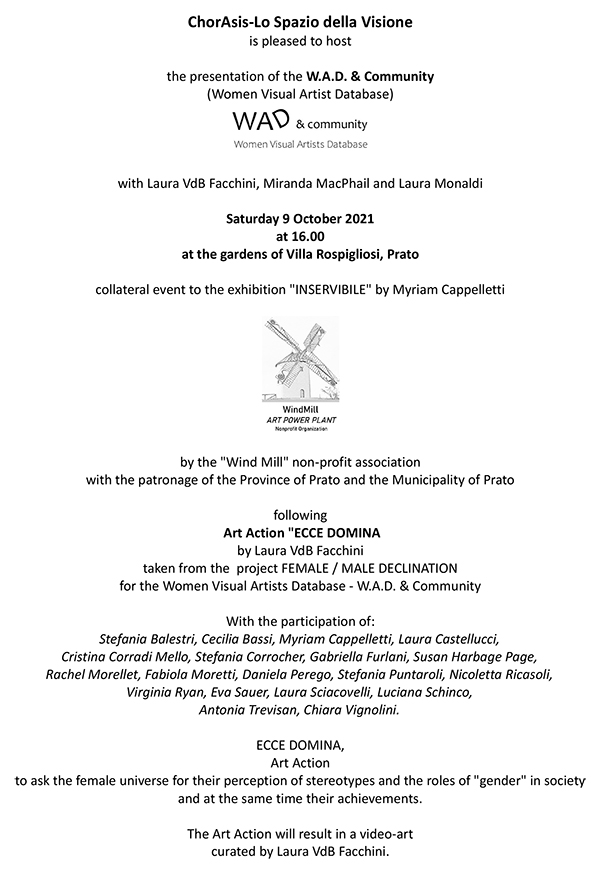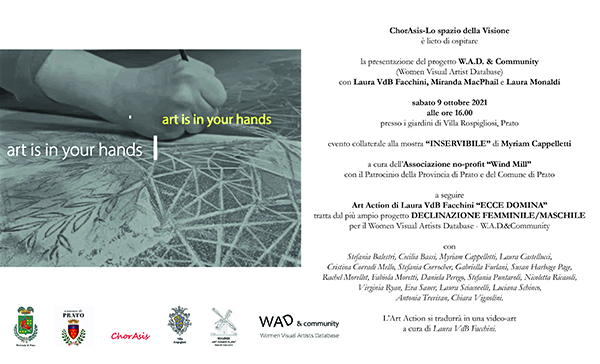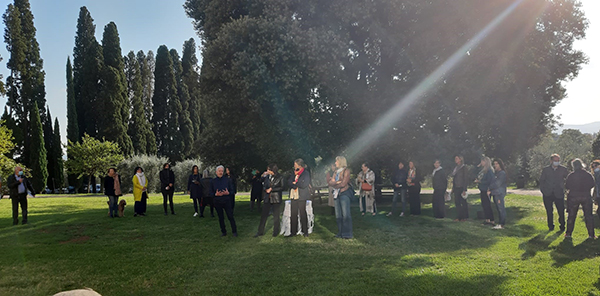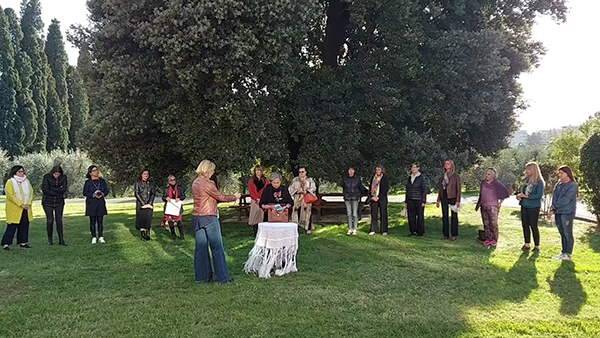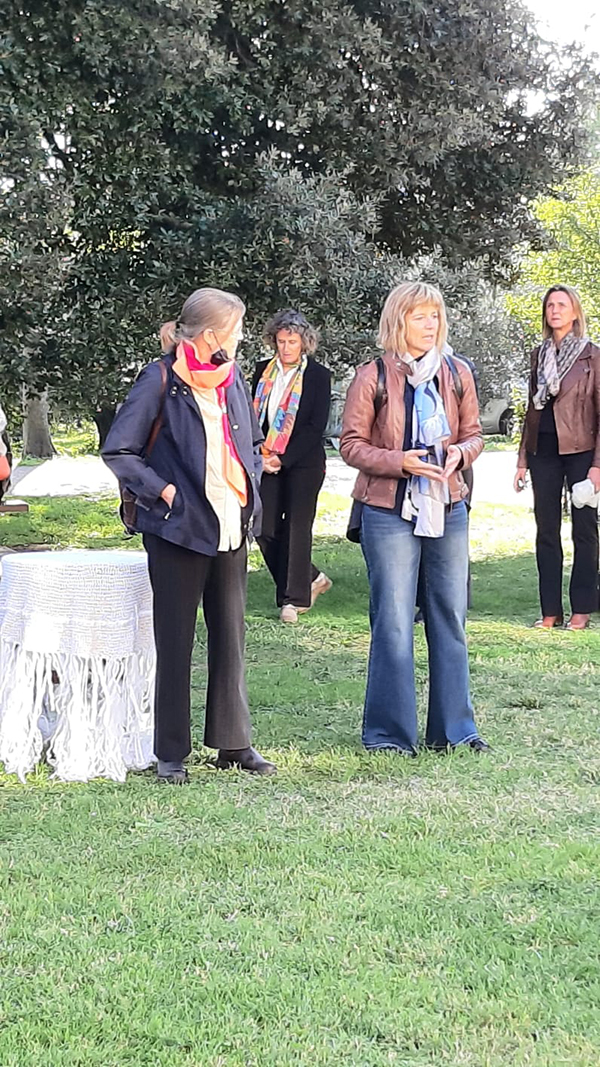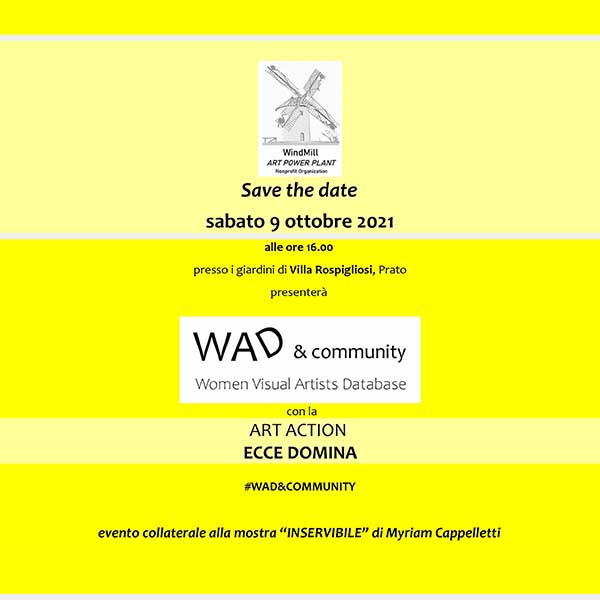ART ACTION ECCE DOMINA
Ecce Domina: Building Feminist Community
Susan Harbage Page
Dreams desires inutile, depression, liberty to travel, toys, consapevolezza, veils, eggshells rosaries, power of women’s friendship.
Susan Harbage Page
A group of international artists, who identify as female, gather on the vibrant green lawn at Villa Rospigliosi, Prato, Italy, on a brisk fall day (October 2021). In the true form of consciousness raising, which grows out of Second-wave feminism and the civil rights movement, we form a semi-circle. Our circle is immediately transformed by the audience into a complete circle. Womanhouse (1972), an early feminist art installation in an old mansion, led by Judy Chicago and Miriam Schapiro flashes through my thoughts because our gathering today reminds me of the scene in which the participants share their stories as they sit cross-legged on the living room floor of the L.A. mansion. I think, also, of the work of the Combahee Women’s River Collective, which centered black feminist lesbian issues. This collective, located in Boston did foundational work on intersectionality in the 70’s. They defined an integrated analysis of the ways in which sex, class, race, and gender are interlocking and how simultaneous oppressions effect the lived experiences of women.
The idea is that each artist presents a small object, such as a frying pan, a photograph, a toy, a tennis shoe, or a photograph of a beloved grandmother, which represents a personal life story about gender roles and stereotypes. We come forward, one at a time, to present our objects and tell the personal story of what that object means to us and how they connect to our gender roles in society, our past, our present, and our future. Each artist is witnessed by the group as they step forward silently, one by one, and place their object on a small round table covered with a handmade textile prepared by Laura V.d.B Facchini, who is the organizer and force behind this art action, Ecce Domina. Some of the objects are placed gently, while others are violently banged on the table in anger and rage. After each woman places her object on the table, she tells her personal story. Some stories are delivered as narratives, some are short poems, and some a single word or phrase.
The narratives include but are not limited to the following: sexual abuse, domestic labor, self-empowerment, friendship, community, depression, uselessness, joy, travel, and liberty. Personal struggles and long-fought victories are made public, some for the first time. They demonstrate the ways in which a patriarchal society and its inherited power abandons some people and supports others, depending on how their gender, sexuality, race, religion, location, and citizenship intersect.
I chose to present a handmade antique lace collar with the poem “From the Inside” which I see as a literal feminist archive. For me, pieces of lace are equivalent to books and documents that we find in libraries. They are ways that women created culture often before societies systems taught them to read and write. This piece of material culture holds the histories, touch, and labor of an unattributed woman who made it possibly as a gift or possibly to support her family. Lace making was often seen as a road to empowerment in traditional monastic settings as well as the secular world. It was an honorable way for a woman to earn a living while remaining in the home. By reading these objects “across the grain,” in new ways, they become a form of feminist knowledge that can be used to decolonize our hegemonic assumptions about the past. They can speak in unique ways to women’s history, resistance, and resilience.
From the Inside
Un ago come se fosse penna, il filo ha la stessa fluidità.
Il lavoro parte dall’interno, creando un archivio.
La sua produzione nel corso della storia conferisce potere alle donne
ma al tempo stesso glielo toglie.
—–
A needle as if it were a pen, the thread has the same fluidity.
The work parts from the inside, creating an archive.
It’s production throughout history empowers women
but at the same time it takes it away.
Susan Harbage Page
We have been encouraged to keep our presentations short so everyone will be honored with the same amount of time. The collective objects we have presented become a temporary archive of personal histories and stories, which connect the group of women. This act of co-witnessing (experiencing) for each other is healing and creates a space which allows memories and stories to be reclaimed from a new perspective in the group context. At the end of the art action we talk, hug, laugh, and recount to the group each story with a bit more background.
The objects brought together for this moment form a temporary feminist archive and archeology of knowledge gathered from different times, geographies, and cultures. This archive is a counter cartography or counter mapping of life allowing space for narratives, which are common but not normally circulated within the dominant culture. They represent the control we have and do not have over our bodies and minds.
Elizabeth Grosz , philosopher and feminist theorist states in her book the Nick of Time (2004) “History is an ‘ongoing revision of the past in the light of its changing relevance to the present’, arguing that the practice of history must be balanced between a certain fidelity to the past and the demands of living in the present in the welcome anticipation of a future.’” With this in mind, each participant has touched a personal or societal struggle or victory from the past and understands it now from a new collective perspective, because it has been shared in a safe community. Our stories reflect the joy, pain, empowerment, and dis-empowerment of our roles and histories as women in society. This new narrative of our life experiences allows us to move more freely into the future with a deeper and empathetic understanding of our present social conditions. Laura V.f. B Faccini comments, “We measure the past and trace the way forward with this action”. We all leave at the end of the day knowing that what is personal is also political.
We know that feminist communities can empower both the collective and the individual to make political change that works toward equality.
The artist participants were:
Stefania Balestri, Cecelia Bassi, Myriam Cappelletti, Laura Castellucci, Stefania Corrocher, Gabriella Furlani, Susan Harbage Page, Rachel Morellet, Fabiola Moretti, Daniela Perego, Stefania Puntaroli, Nicoletta Ricasoli, Virginia Ryan, Eva Sauer, Laura Sciacovelli, Luciana Schinco, Antonia Trevison, Chiara Vignolini.
